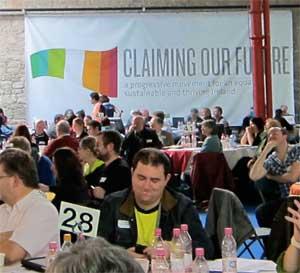Claiming Our Future's Plan B: a viable alternative

Claiming Our Future outlined last night on the Tonight with Vincent Browne show it's Plan B, which includes a number of proposals that are viable alternatives to the Government's planned austerity budget in December ((watch below). One proposal that Vincent Browne questioned on his show includes investing funds from the National Pension Reserve Fund (NPRF).
It is important to note that it is unlikely that the NPRF is going to return anytime soon to becoming a saving fund for future pensions and there is no provision for Exchequer contributions up to 2015. The Government has stated that it will be using it for commercial-return projects such as the installation of water meters. So, clearly, the Fund is open for use. Establishing a Strategic Investment Bank as outlined in the Programme for Government could be a mechanism to invest funds from the NPRF. The value of the NPFR discretionary portfolio was €5.4 billion at 31 December 2011 according to the NTMA Results and Business Review. Indeed Fine Gael's new Era Plan, in its pre-election manifesto, the Construction Industry Federation and SIPTU make a similar claim that the NPRF could be used as for an investment programme in infrastructure development.
As stated in Plan B using the Government's cash reserves is an important mechanism to start the investment programme. Davy (May 17, 2012, Deficit Reduction Plan) estimates that cash balances currently stand at €14.4 billion. It is planned that this will be run down by approximately €4 billion by 2015 to pay down the debt. This money could be better used front-loading a multi-year investment programme.
In terms of potential employment creation from such investment, the Department of Finance (July 2010, Infrastructure Investment Priorities 2010-2016 , p 14) estimate that the labour intensity of capital projects falls within the range of 8 - 12 jobs for every €1 million invested. So, as stated in Plan B; 8-12,000 jobs for each €1bn investment.
Claiming Our Future also outlines in Plan B the possibilities of raising significant finance from taxing higher incomes and wealth rather than lower income households that have suffered disproportionally to date from austerity budgets. Michael Taft in November last year analysed a number of proposals which are all backed up by data from the Department of Finance and Parliamentary Questions to the relevant Minister. These outlined, as put forward in Plan B, the following possibilities:
- A wealth tax that could yield between €500 and €800 million
- A property or site-value tax that could raise €800 million
- Abolition of property tax reliefs that could raise €450 million.
- Reduce interest relief for landlords that could raise between €350 - €400 million
- Increasing the top rate of tax to 48 percent that could raise €410 million.
- Standardise discretionary tax reliefs that could raise €628 million.
Taft also makes the argument that the Government wouldn't need €3.1 billion adjustments to achieve the Government's deficit reduction targets if it were driven by taxation. This is because tax increases are more efficient at reducing the deficit than spending cuts. €3 billion in tax increases reduces the deficit in the first year by €2.4 billion; while €3 billion in spending cuts only reduces the deficit by €1.8 billion. This is because spending cuts are more deflationary.
The next budget will be the sixth austerity budget in a row. The evidence shows clearly that it is not working. Nobel prize winning economists such as Paul Krugman make it clear that austerity depresses the economy as economic analysis shows that reducing the income of lower income households dampens domestic demand. The Government's current Plan A is likely to result in unemployment remaining over 10%, shrinking public services, further contraction and prolonged misery.
The reality is that, if it so desired, the Irish Government could undertake a stimulus programme. It is also important to state that Plan B is not dependent on additional lending from EU institutions or a writedown of debt, however, these would add strongly to supporting a stimulus. We believe that the case should be made stronger at EU level that our debt is unsustainable and a European-wide stimulus programme is neccessary.
Our Plan B raises the possibility of alternatives that economically make sense and share the burden more equally. We have tried to explain the alternatives in a language that most people can access and understand in order to start a debate that we hope can include, not just government ministers and economists, but also the so-called 'ordinary' people across the country. The social costs of another austerity budget of welfare cuts and an absence of a real jobs investment plan are too high. Through Plan B we are promoting a serious discussion of real alternatives.
Read more on Plan be from Michael Taft here and Vincent Browne here. An excerpt on the debate on TV3's Tonight show is below. Videos from the Plan B launch are also below:
